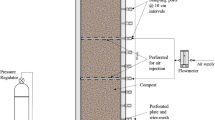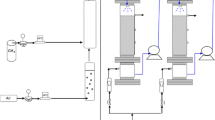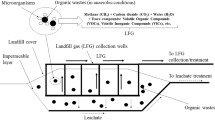Abstract
Methane is a potent greenhouse gas with a global warming potential ~23 times that of carbon dioxide. Here, we describe the modeling of a biotrickling filtration system composed of methane-consuming bacteria, i.e., methanotrophs, to assess the utility of these systems in removing methane from the atmosphere. Model results indicate that assuming the global average atmospheric concentration of methane, 1.7 ppmv, methane removal is ineffective using these methanotrophic biofilters as the methane concentration is too low to enable cell survival. If the concentration is increased to 500–6,000 ppmv, however, similar to that found above landfills and in concentrated animal feeding operations (factory farms), 4.98–35.7 tons of methane can be removed per biofilter per year assuming biotrickling filters of typical size (3.66 m in diameter and 11.5 m in height). Using reported ranges of capital, operational, and maintenance costs, the cost of the equivalent ton of CO2 removal using these systems is $90–$910 ($2,070–$20,900 per ton of methane), depending on the influent concentration of methane and if heating is required. The use of methanotrophic biofilters for controlling methane emissions is technically feasible and, provided that either the costs of biofilter construction and operation are reduced or the value of CO2 credits is increased, can also be economically attractive.




Similar content being viewed by others
References
Aizpuru A, Khammar N, Malhautier L, Fanlo JL (2003) Biofiltration for the treatment of complex mixtures of VOC: influence of the packing material. Acta Biotechnol 23:211–226
Alonso C, Suidan MT, Sorial GA, Smith FL, Biswas P, Smith PJ, Brenner RC (1997) Gas treatment in trickle-bed biofilters: biomass, how much is enough? Biotechnol Bioeng 54:583–594
Amaral JA, Ren T, Knowles R (1998) Atmospheric methane consumption by forest soils and extracted bacteria at different pH values. Appl Environ Microbiol 64:2397–2402
Arcangeli J, Arvin E (1999) Modelling the growth of a methanotrophic biofilm: estimation of parameters and variability. Biodegrad 10:177–191
Blaha D, Bartlett K, Czepiel P, Harriss R, Crill P (1999) Natural and anthropogenic methane sources in New England. Atmos Environ 33:243–255
Börjesson G, Sundh I, Tunlid A, Svensson BH (1998) Methane oxidation in landfill cover soils, as revealed by potential oxidation measurements and phospholipid fatty acid analyses. Soil Biol Biochem 30:1423–1433
Bousquet P, Ciais P, Miller JB, Dlugokencky EJ, Hauglustaine DA, Prigent C, Van der Werf GR, Peylin P, Brunke EG, Carouge C, Langenfelds RL, Lathière J, Papa F, Ramonet M, Schmidt M, Steele LP, Tyler SC, White J (2006) Contribution of anthropogenic and natural sources to atmospheric methane variability. Nature 443:439–443
Bull ID, Parekh NR, Hall GH, Ineson P, Evershed RP (2000) Detection and classification of atmospheric methane oxidizing bacteria in soil. Nature 405:175–178
Carman RE, Vincent RK (1998) Measurements of soil gas and atmospheric methane content on one active and two inactive landfills in Wood County, Ohio. Environ Eng Geosci 4:317–329
Cohen Y (2001) Biofiltration–the treatment of fluids by microorganisms immobilized into the filter bedding material: a review. Bioresour Technol 77:257–274
Cox HHJ, Deshusses MA (1999) Chemical removal of biomass from waste air biotrickling filters: screening of chemicals of potential interest. Water Res 33:2383–2391
Cox HHJ, Deshusses MA (2002) Biotrickling filters for air pollution control. In: Bitton G (ed) The encyclopedia of environmental microbiology, vol 2. Wiley, New York, pp 782–795
Cox HHJ, Moerman RE, van Baalen S, van Heiningen WNM, Doddema HJ, Harder W (1997) Performance of a styrene-degrading biofilter containing the yeast Exophiala jeanselmei. Biotechnol Bioeng 53:259–266
Dalton H (1991) Structure and mechanism of action of the enzyme(s) involved in methane oxidation. In: Kelly JW, Baldwin TO (eds) Applications of enzyme biotechnology. Plenum, New York, pp 55–68
Dever SA, Swarbrick GE, Stuetz RM (2007) Passive drainage and biofiltration of landfill gas: Australian field trial. Waste Manag 27:277–286
Dunfield PF, Conrad R (2000) Starvation alters the apparent half-saturation constant for methane in the type II methanotroph Methylocystis strain LR1. Appl Environ Microbiol 66:4136–4138
Dunfield PF, Liesack W, Henckel T, Knowles R, Conrad R (1999) High-affinity methane oxidation by a soil enrichment culture containing a type II methanotroph. Appl Environ Microbiol 65:1009–1014
Energy Information Administration (2007) Average retail price of electricity to ultimate customers by end-use sector. Available via DIALOG. http://www.eia.doe.gov/cneaf/electricity/epa/epat7p4.html. Accessed Nov 15 2008
Etheridge DM, Steele LP, Francey RJ, Langenfelds RL (1998) Atmospheric methane between 1000 A. D. and present: evidence of anthropogenic emissions and climatic variability. J Geophys Res 103:15979–15993
Fry VA, Istok JD, Semprini L, O'Reilly KT, Buscheck TE (1995) Retardation of dissolved oxygen due to a trapped gas phase in porous media. Ground Water 33:391–398
Gabriel D, Deshusses MA (2003) Retrofitting existing chemical scrubbers to biotrickling filters for H2S emission control. Proc Natl Acad Sci 100:6308–6312
Gabriel D, Cox HHJ, Deshusses MA (2004) Conversion of full-scale wet scrubbers to biotrickling filters for H2S control at publicly owned treatment works. J Environ Eng 130:1110–1117
Hanson RS, Hanson TE (1996) Methanotrophic bacteria. Microbiol Rev 60:439–471
Hartman B (1998) Investigation and Remediation: Oh Henry! (a constant). LUSTLine Bull 29:17–18
Hildebrand JH (1969) Relative diffusivities of methane in water and carbon tetrachloride. Proc Natl Acad Sci 64:1329–1330
Iranpour R, Cox HHJ, Deshusses MA, Schroeder ED (2005) Literature review of air pollution control biofilters and biotrickling filters for odor and volatile organic compound removal. Environ Prog 24:254–267
Kennes C, Veiga MC (2002) Inert filter media for the biofiltration of waste gases–characteristics and biomass control. Rev Environ Sci Biotechnol 1:201–214
Kennes C, Cox HHJ, Doddema HJ, Harder W (1996) Design and performance of biofilters for the removal of alkylbenzene vapors. J Chem Technol Biotechnol 66:300–304
Knief C, Vanitchung S, Harvey NW, Conrad R, Dunfield PF, Chidthaisong A (2005) Diversity of methanotrophic bacteria in tropical upland soils under different land uses. Appl Environ Microbiol 71:3826–3831
Lee S, Keeney DR, Lim D, Dispirito AA, Semrau JD (2006) Mixed pollutant degradation by Methylosinus trichosporium OB3b expressing either soluble or particulate methane monooxygenase: can the tortoise beat the hare? Appl Environ Microbiol 72:7503–7509
Le Mer J, Roger P (2001) Production, oxidation, emission and consumption of methane by soils: a review. Eur J Soil Biol 37:25–50
Le Texier H, Solomon S, Garcia RR (1988) The role of molecular hydrogen and methane oxidation in the water vapour budget of the stratosphere. QJR Meteorol Soc 114:281–295
Lieberman RL, Rosenzweig AC (2004) Biological methane oxidation: regulation, biochemistry, and active site structure of particulate methane monooxygenase. Crit Rev Biochem Mol Biol 39:147–164
Lontoh S, Semrau JD (1998) Methane and trichloroethylene degradation by Methylosinus trichosporium OB3b expressing particulate methane monooxygenase. Appl Environ Microbiol 64:1106–1114
Melse RW, van der Werf AW (2005) Biofiltration for mitigation of methane emission from animal husbandry. Environ Sci Technol 39:5460–5468
Nikiema J, Bibeau L, Lavoie J, Brzezinski R, Vigneux J, Heitz M (2005) Biofiltration of methane: an experimental study. Chem Eng J 113:111–117
Okkerse WJH, Ottengraf SPP, Diks RMM, Osinga-Kuipers B, Jacobs P (1999) Long term performance of biotrickling filters removing a mixture of volatile organic compounds from an artificial waste gas: dichloromethane and methylmethacrylate. Bioprocess Biosyst Eng 20:49–57
Oldenhuis R, Vink RL, Janssen DB, Witholt B (1989) Degradation of chlorinated aliphatic hydrocarbons by Methylosinus trichosporium OB3b expressing soluble methane monooxygenase. Appl Environ Microbiol 55:2819–2826
Parliamentary Office of Science and Technology, United Kingdom (2006) Carbon footprint of electricity generation. POST Rep. 66. London: Parliamentary Office of Science and Technology
Prior SD, Dalton H (1985) The effect of copper ions on membrane content and methane monooxygenase activity in methanol-grown cells of Methylococcus capsulatus (Bath). J Gen Microbiol 131:155–163
Rittmann BE (1982) The effect of shear stress on biofilm loss rate. Biotechnol Bioeng 42:501–506
Sipkema EM, de Koning W, Ganzeveld KJ, Janssen DB, Beenackers AACM (1998) Experimental pulse technique for the study of microbial kinetics in continuous culture. J Biotechnol 64:159–176
Song J, Kinney KA (2001) Effect of directional switching frequency on toluene degradation in a vapor-phase bioreactor. Appl Microbiol Biotechnol 56:108–113
Sundh I, Mikkela C, Nilsson M, Svensson BH (1995) Potential aerobic methane oxidation in a sphagnum-dominated peatland–controlling factors and relation to methane emission. Soil Biol Biochem 27:829–837
van Bodegom P, Stams F, Mollema L, Boeke S, Leffelaar P (2001) Methane oxidation and the competition for oxygen in the rice rhizosphere. Appl Environ Microbiol 67:3586–3597
van Groenestijn JW, Kraakman NJR (2005) Recent developments in biological waste gas purification in Europe. Chem Eng J 113:85–91
Wahlen M (1993) The global methane cycle. Annu Rev Earth Planet Sci 21:407–426
Yoon S, Semrau JD (2008) Measurement and modeling of multiple substrate oxidation by methanotrophs at 20 °C. FEMS Microbiol Lett 287:156–162
Acknowledgments
Support from the Page Foundation and the US Department of Energy (DE-FC26-05NT42431) is gratefully acknowledged.
Author information
Authors and Affiliations
Corresponding author
Rights and permissions
About this article
Cite this article
Yoon, S., Carey, J.N. & Semrau, J.D. Feasibility of atmospheric methane removal using methanotrophic biotrickling filters. Appl Microbiol Biotechnol 83, 949–956 (2009). https://doi.org/10.1007/s00253-009-1977-9
Received:
Revised:
Accepted:
Published:
Issue Date:
DOI: https://doi.org/10.1007/s00253-009-1977-9




